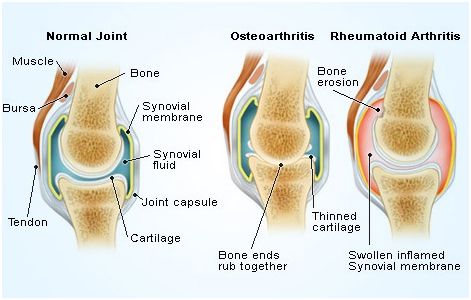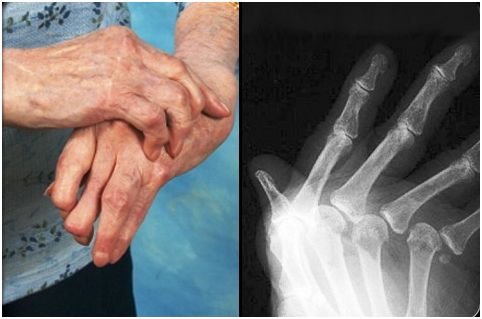What is Arthritis ?
Arthritis is an umbrella term for over 100 medical conditions that affect your joints. Arthritis related problems include pain, stiffness, inflammation and damage to joint cartilage (tissue that covers the end of the bones, enabling them to move against) and surrounding structures. This can result in joint weakness, instability and deformities that can interfere with the most basic daily tasks such as walking, driving a car and preparing food.
As the population ages, the number of people with arthritis is growing. There is a widely held belief that arthritis is simply a consequence of age. But it is not a natural part of ageing. In fact, there is millions of working age sufferers. Research suggests that early intervention can delay the onset of the disease and may reduce the number of cases of osteoarthritis.
While there are about 100 forms of arthritis, the three most common causes account for 95% of all arthritis. These are:
Osteoarthritis
Rheumatoid arthritis
Psoriatic Arthritis
There is no known cure for arthritis. However arthritis usually manageable but can impact on your quality of life and includes varying degrees of discomfort and pain.

Arthritis
OSTEOARTHRITIS
Often called “wear and tear” arthritis, osteoarthritis (OA) is the most common form of arthritis. In most cases, over time, cartilage in joints breaks down, and OA symptoms begin to occur. OA is most commonly found in the:
Knees
Hips
Hands and fingers
Spine
Wrists, elbows, shoulders, and ankles can also be affected by OA, but this occurs less frequently. When OA is found in these joints, there may have been a history of injury or stress to that joint.

Difference between arthritic joint and healthy joint
Symptoms of Osteoarthritis
OA comes on slowly. For many, the first signs are joints that ache after physical work or exercise. As the disease progresses, other most common symptoms include:
- Pain in a joint
- Swelling or tenderness in one or more joints
- Stiffness after periods of inactivity, such as sleeping or sitting
- Flare-ups of pain and inflammation after use of the affected joint
- Crunching feeling or sound of bone rubbing on bone (called crepitus) when the joint is used
OA most often occurs in the following areas:
Knees
Because knees are primarily weight-bearing joints, they are very commonly affected by OA. If you have OA in your knees, you may feel that these joints are stiff, swollen, and painful, making it hard to walk, climb, and get in and out of chairs and bathtubs.
Hips
OA in the hip can cause pain, stiffness, and severe disability. Hips both support the weight of the body and enable movement of your lower body. When you have OA in your hips, you may also feel the pain in your groin, inner thigh, or knees. OA in the hip can lead to difficulty moving, bending, and walking.
Fingers and Hand
When OA occurs in hands and fingers, the base of the thumb joint is commonly affected and people experience stiffness, numbness, and aching.
Spine
If you have OA of the spine, you may experience stiffness and pain in the neck or in the lower back. Sometimes arthritis-related changes in the spine can put pressure on the nerves, causing weakness or numbness in your arms or legs.
What Causes Osteoarthritis ?
While the exact cause of OA is unknown, joint damage can be due to repetitive movement (also known as “wear and tear’). It can also begin as the result of an injury. Either way, with OA there’s erosion of the cartilage, the part of the joint that covers the ends of the bones.
Osteoarthritis Diagnosis
The doctor will probably give you a physical examination to check your general health, and examine the joints that are bothering you.
You may also need other tests to help confirm the diagnosis of OA and determine the extent and severity of joint damage. Some of these may include:
X-rays
Joint Aspiration

X-ray view of arthritis affected joint
RHEUMATOID ARTHRITIS
Rheumatoid arthritis (RA) is an autoimmune disease where the body’s immune system attacks normal joint tissues, causing inflammation of the joint lining.
This inflammation of the joint lining (called the synovium) can cause pain, stiffness, swelling, warmth, and redness. The affected joint may also lose its shape, resulting in loss of normal movement. RA is an ongoing disease, with active periods of pain and inflammation, known as flares, alternating with periods of remission, when pain and inflammation disappear.
RA can affect many different joints. In some people, it can even affect parts of the body other than the joints, including the eyes, blood, the lungs, and the heart.
Symptoms of Rheumatoid Arthritis
Although RA is often a chronic disease, the severity and duration of symptoms may unpredictably come and go.
With RA, people experience periods of increased disease activity, called flare-ups or flares, alternating with periods when the symptoms fade or disappear, called remission.
- Pain and stiffness lasting for more than 1 hour in the morning or after a long rest
- Joint inflammation in the joints closest to the hand, such as wrist and fingers, although the neck, shoulders, elbows, hips, knees, ankles, and feet can also be affected
- Symmetrical pattern of inflammation, meaning both sides of the body are usually affected at the same time
- Fatigue, an occasional fever, and a general sense of not feeling well (called malaise).
What Causes Rheumatoid Arthritis ?
The exact causes of RA are unknown. But research has shown that several factors may contribute to the development of RA:
- Genetic – Certain genes play a role in the immune system — for some people, genetic factors may be involved in determining whether they will develop RA.
- Environmental – In people who have inherited a genetic tendency for the disease, RA can be triggered by an infection.
Rheumatoid Arthritis Diagnosis
Early diagnosis and treatment can help slow disease progression.
Your medical history and examination of the joints helps in diagnosis of RA. Other tests to help confirm the diagnosis of RA and determine the extent and severity of joint damage are:
Blood Tests
X-rays
Treatment
It’s important to understand that although there is no way to reverse the cartilage loss of osteoarthritis or rheumatoid arthritis, there are treatment options available to help you relieve the symptoms. These can include:
- Medications
- Exercise
- Diet
- Surgery
Low Level Laser Therapy Treatment for Arthritis
Low Level Laser Therapy (LLLT) is the application of red and near infrared light over injuries to stimulate cellular repair. LLLT has a powerful anti-inflammatory effect as well as a healing effect.
LLLT application on the tender joints is effective at reducing pain and morning stiffness. Exposure to LLLT has been shown to result in:
- Anti-inflammatory and analgesic effects
- Increased protein synthesis of rheumatoid synovial cells
- Normalization of the permeability of the synovial membrane and
- Enhancement of regional microcirculation
The laser energy irradiates inflamed synovial cells and modifies the level of antigen-antibody complexes and helps stabilize the membranes in rheumatoid arthritis patients.
The end result is reduction of inflammation and pain. Once the pain is eliminated and normal range of motion and function is restored. Then muscle and tendon strength and flexibility can be addressed with graduated exercises and stretching.
LLLT has no known side effects, is safe and effective.

